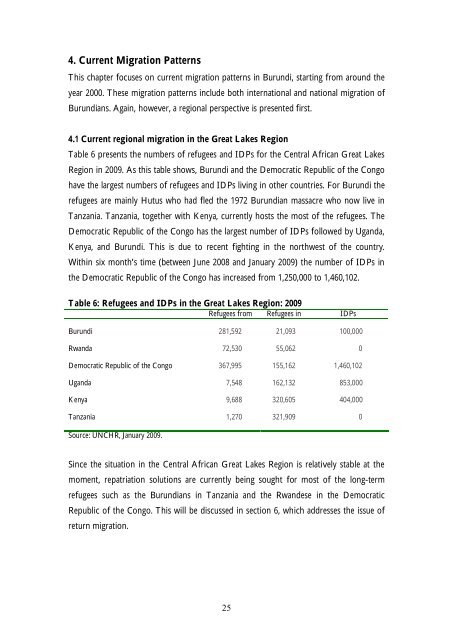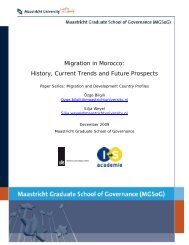Migration in Burundi: History, Current Trends and Future - MGSoG ...
Migration in Burundi: History, Current Trends and Future - MGSoG ...
Migration in Burundi: History, Current Trends and Future - MGSoG ...
Create successful ePaper yourself
Turn your PDF publications into a flip-book with our unique Google optimized e-Paper software.
4. <strong>Current</strong> <strong>Migration</strong> Patterns<br />
This chapter focuses on current migration patterns <strong>in</strong> <strong>Burundi</strong>, start<strong>in</strong>g from around the<br />
year 2000. These migration patterns <strong>in</strong>clude both <strong>in</strong>ternational <strong>and</strong> national migration of<br />
<strong>Burundi</strong>ans. Aga<strong>in</strong>, however, a regional perspective is presented first.<br />
4.1 <strong>Current</strong> regional migration <strong>in</strong> the Great Lakes Region<br />
Table 6 presents the numbers of refugees <strong>and</strong> IDPs for the Central African Great Lakes<br />
Region <strong>in</strong> 2009. As this table shows, <strong>Burundi</strong> <strong>and</strong> the Democratic Republic of the Congo<br />
have the largest numbers of refugees <strong>and</strong> IDPs liv<strong>in</strong>g <strong>in</strong> other countries. For <strong>Burundi</strong> the<br />
refugees are ma<strong>in</strong>ly Hutus who had fled the 1972 <strong>Burundi</strong>an massacre who now live <strong>in</strong><br />
Tanzania. Tanzania, together with Kenya, currently hosts the most of the refugees. The<br />
Democratic Republic of the Congo has the largest number of IDPs followed by Ug<strong>and</strong>a,<br />
Kenya, <strong>and</strong> <strong>Burundi</strong>. This is due to recent fight<strong>in</strong>g <strong>in</strong> the northwest of the country.<br />
With<strong>in</strong> six month’s time (between June 2008 <strong>and</strong> January 2009) the number of IDPs <strong>in</strong><br />
the Democratic Republic of the Congo has <strong>in</strong>creased from 1,250,000 to 1,460,102.<br />
Table 6: Refugees <strong>and</strong> IDPs <strong>in</strong> the Great Lakes Region: 2009<br />
Refugees from Refugees <strong>in</strong> IDPs<br />
<strong>Burundi</strong> 281,592 21,093 100,000<br />
Rw<strong>and</strong>a 72,530 55,062 0<br />
Democratic Republic of the Congo 367,995 155,162 1,460,102<br />
Ug<strong>and</strong>a 7,548 162,132 853,000<br />
Kenya 9,688 320,605 404,000<br />
Tanzania 1,270 321,909 0<br />
Source: UNCHR, January 2009.<br />
S<strong>in</strong>ce the situation <strong>in</strong> the Central African Great Lakes Region is relatively stable at the<br />
moment, repatriation solutions are currently be<strong>in</strong>g sought for most of the long-term<br />
refugees such as the <strong>Burundi</strong>ans <strong>in</strong> Tanzania <strong>and</strong> the Rw<strong>and</strong>ese <strong>in</strong> the Democratic<br />
Republic of the Congo. This will be discussed <strong>in</strong> section 6, which addresses the issue of<br />
return migration.<br />
25



